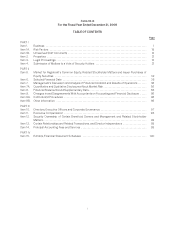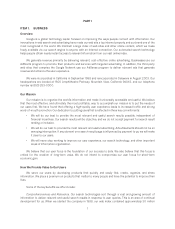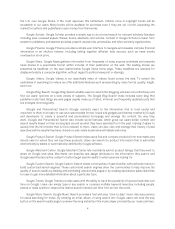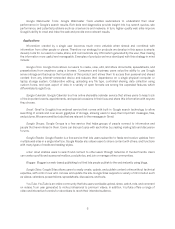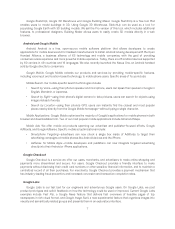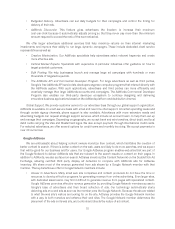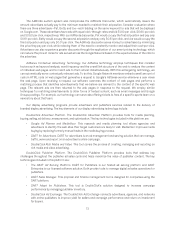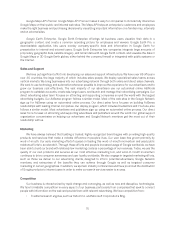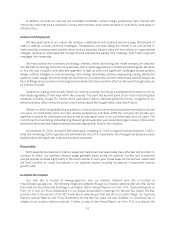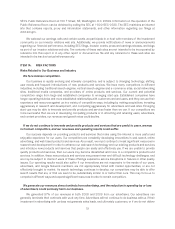Google 2009 Annual Report Download - page 27
Download and view the complete annual report
Please find page 27 of the 2009 Google annual report below. You can navigate through the pages in the report by either clicking on the pages listed below, or by using the keyword search tool below to find specific information within the annual report.Advertisers in our AdWords program create text-based or display ads, bid on the keywords that will trigger the
display of their ads and set daily spending budgets. AdWords features an automated online signup process that
lets advertisers quickly implement ad campaigns on Google properties and the web sites of our Google Network
members. Ads are ranked for display in AdWords based on a combination of the maximum cost-per-click pricing
set by the advertiser and click-through rates and other factors used to determine the relevance of the ads. This
favors the ads that are most relevant to users, improving the experience both for the person looking for
information and for the advertiser who is generating relevant ads. The AdWords program offers advertisers the
following additional benefits:
Return on Investment. Many advertising dollars are spent delivering messages in an untargeted fashion, and
payment for these advertisements is not tied to performance. AdWords shows ads only to users seeking
information related to what the advertisers are selling, and advertisers choose how much they want to pay
when a user clicks on their ad. Because we offer a simple ad format, advertisers can also avoid incurring
significant costs associated with creating ads. As a result, even small advertisers find AdWords cost-effective
for connecting with potential customers. In addition, advertisers can create many different ads, increasing the
likelihood that an ad is suited to a user’s search. Users can find advertisements for what they are seeking, and
advertisers can find users who want what they are offering.
Branding. In addition to our cost-per-click pricing model, we also allow advertisers to pay on a
cost-per-impression basis on the Google Network. We also offer Placement Targeting, a service that lets
advertisers target specific web sites with text and display ads, so that they can more effectively reach specific
sets of customers. In addition to targeting sites by content, advertisers can choose placements on sites based
on user demographic attributes. To protect user privacy, we use only third-party opt-in panel data to map the
demographics of sites in our networks. Placement Targeting is an auction-based system where placement
targeted ads compete with keyword-targeted ads in the same auction.
Access to the Google Search and Content Network. We serve AdWords ads on Google properties, our
syndicated search partners’ web sites, and the millions of third-party web sites that make up the
Google Network. As a result, we can offer extensive search and content inventory on which advertisers can
advertise. Apart from keyword-based ads targeted to search queries and Placement Targeting, we also offer
advertisers an effective contextual advertising option—Content Targeting—that displays their ads on relevant
content pages across our network of partner sites and products. As a result, AdWords advertisers can target
users on Google properties and on search and content sites across the web. This gives advertisers increased
exposure to users who are likely to be interested in their offerings. The Google Network significantly enhances
our ability to attract interested advertisers.
Campaign Control. Google AdWords gives advertisers hands-on control over most elements of their ad
campaigns. Advertisers can specify the relevant search or content topics for each of their ads. Advertisers
can also manage expenditures by setting a maximum daily budget and determining how much they are willing
to pay whenever a user clicks or views an ad. Other features that make it easy to set up and manage ad
campaigns include:
•Campaign Management. Advertisers can target multiple ads to a given keyword and easily track individual
ad performance to see which ads are the most effective.
•Conversion Tracking. Conversion tracking is a free tool integrated into AdWords reports that measures
the conversions of an advertiser’s campaigns, enabling a better understanding of the overall return on
investment generated for the advertiser by the AdWords program.
•Traffic Estimator. This tool estimates the number of searches and potential costs related to advertising
on a particular keyword or set of keywords.
•Quality-Based Bidding. Advertisers’ keywords are assigned dynamic first page bids based on their Quality
Score—the higher the Quality Score, the lower the first page bid. This rewards advertisers with relevant
keywords and ads.
9


